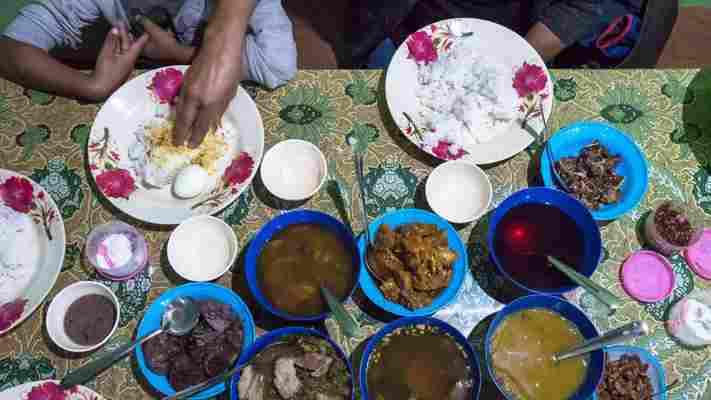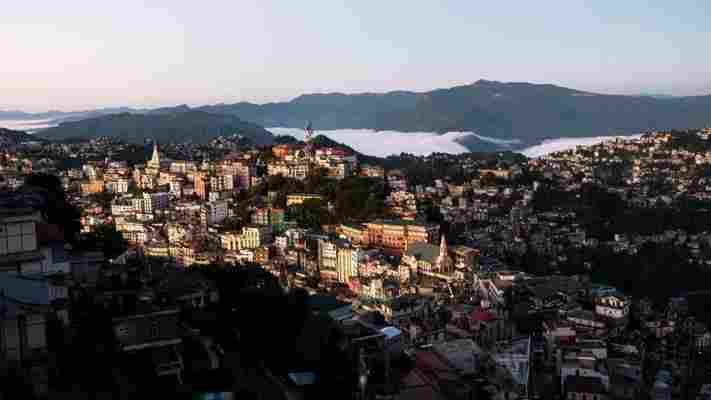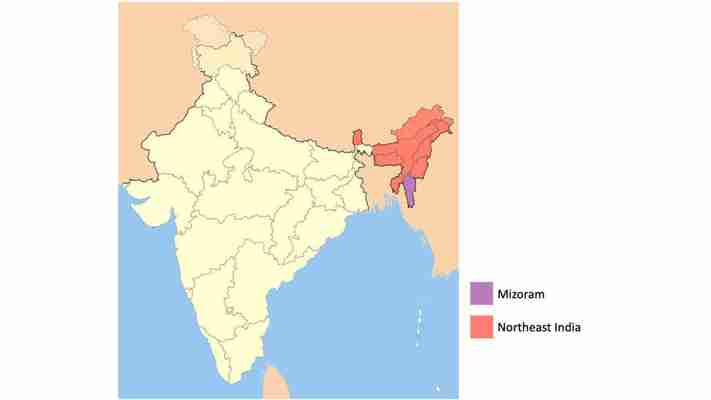Crowing roosters and pink-streaked skies suggest it’s time for early rousers to stir. But the clock shows barely 05:00 even though the light seems much too bright for a wintry morning. Less than an hour later, the entire hilltop city of Aizawl is awash in sunlight, the sudden warming of air causing clouds to scurry down to colder valleys below – a common spectacle in these hills at this time of year.

The landscape, people, culture and cuisine here differ completely from all that the mainland is known for
This seemingly horological discrepancy is a part of daily life in this Indian region collectively called the Northeast, a geographic salient that extends from the foothills of the Himalayas just south of the Tibetan Autonomous Region all the way down to the flood plains of Bangladesh, with Myanmar to its east. Although the borders and clocks of the eight states that make up this disparate region are bound to India, there is little else to suggest the fact. The landscape, people, culture and cuisine here differ completely from all that the mainland is known for.

Bound to Indian time, the sunrise in Aizawl can happen as early as 4 or 5am (Credit: Pearly Jacob)
Like many of its neighbouring states, Mizoram became part of India following independence from British rule in 1947. Its rugged hills were once considered wild and untameable because of the warring headhunting hill-tribes who lived there. After forceful military subjugation of the tribes by the British, Welsh missionaries were sent in to convert many of the tribes to Christianity . Today, close to 90% of Mizoram’s inhabitants are Christians, with church steeples an indelible part of the concrete mass of buildings precariously perched on the steep slopes of the state capital, Aizawl.
While Mizos may have given up their animist gods, they’ve clung on to their tribal cuisine. Various stews of roots, shoots and leaves eaten with hearty accompaniments of meat and rice still dominate the two main meals of the day – a late breakfast and an early dinner eaten just before sundown. In this remote frontier, closer both in air and road miles to Bangkok than the national capital of New Delhi, curry is an alien concept replaced instead by bai , a kind of brothy stew that serves as the quintessential essence of a Mizo meal. Just as its spice-laden mainland equivalent has many different variations, recipes for bai are as diverse as the produce that locals harvest for the table.

Map of India, highlighting the state of Mizoram in its Northeast region
You may also be interested in: • India’s brilliant Bombay duck • The surprising truth about Indian food • The Indian burger McDonald’s can’t master
Thanks to the Chinese, the bamboo shoot may have become one of world’s most widely eaten shoots. But Mizos also love the shoots and tender stems of many other plants, including banana, slender cane, taro and those of an indigenous family of the banana that Mizos call saisu, or Musa glauca in Latin.
Seasonal local favourites include indigenous wild plants such as baibing , the spiky inflorescence of a local variety of Alocasia fornicate – the same family as anthuriums and peace lilies. Besides more exotic species, the leaves and stems of innocuous everyday plants such as passionfruit, pumpkins, yams, beans and squash are more favoured than their fruits, each season determining which part is harvested for the table.
Bitter berries locals call tawkte and onion roots are usually used for making chutneys (Credit: Pearly Jacob)
Some favourite dishes include maian bai, young pumpkin leaves stewed with a few strands of dried leaves of the rosella plant that locals call anthur ; or behlwai bai , young string bean leaves simmered in a pork stock with a bit of rice to thicken the broth, and tempered with a dash of fermented pork fat called sa-um to finish.
Common leaves and herbs used to add extra flavour to bai include chingiit , a close relative of the Sichuan pepper; and what Mizos call bahkhawr , whose spiky leaves are known as culantro or Asian cilantro in English. Also favoured are the flowers of an indigenous plant called lengser or the Mizo lomba ( Elsholtzia blanda ). Its sharp citrusy flavour is often compared to that of the lemongrass used in South-East Asian recipes.
While the Mizo diet may read like a botanical index, no meal is complete without generous portions of meat such as pork, chicken and beef and their smoked varieties. Classic recipes include smoked pork boiled with mustard leaves that add a distinct peppery zing to the rich broth; and sawchair , a rice-based, congee-like stew made from chicken or pork with strands of anthur to infuse tangy notes. Blood sausages and herby chutneys made from the more gristly animal parts usually show up as special items in feasts. Ginger, garlic and turmeric added to stir-fried vegetables like potatoes or cauliflower are perhaps the only shared spices with the Indian mainland.
Stalls sell mustard greens wrapped in banana leaves, young bamboo shoots and jaggery (Credit: Pearly Jacob)
The origins of Mizo people are shrouded in mystery, but they are believed to have migrated over centuries from South China and still share close language, ethnic and culinary ties with many hill tribes of west Myanmar. Their widespread use of fermented soybean, known locally as bekang , as a flavouring for stews or mixed with chillies as a side dish for rice also suggests ancient culinary links with East Asian countries as far as Korea and Japan.
As they did in ancient times, Mizos prefer their bekang made from tiny soybeans imported from Myanmar, according to 78-year-old Aizawl bekang maker, Zakiamloa, who like most Mizos uses only one name. Mizo bekang is not unlike Japanese natto , though it’s less pungent and also less slimy. Fermenting bekang is a painstaking process that involves soaking and steaming the soybeans overnight and leaving them on a warm hearth for three days on dried leaves of the Callicarpa arborea tree (locally known as hnakiah ) to aid fermentation, before portions are neatly wrapped up in fresh banana leaves for sale.
“I’ve built my house and raised my children with bekang,” said Zakiamloa, who believes little has changed in the Mizo diet for centuries, though daily meals nowadays would have been the celebratory feasts of their ancestors. Despite the recent arrival of fast-food chains like KFC, he believes it’s the Mizo dedication to their tribal diet that has helped many traditional food producers like himself run successful businesses. Most outside food, even common Indian breads like puris and rotis or the widely sold Tibetan momo dumplings and fried noodles, are only eaten as snacks between meals.
Mizo meals feature staples like smoked pork boiled with mustard leaves and bai (Credit: Pearly Jacob)
Due to its geographic remoteness, much of the cuisine and culture of the Northeast remain a mystery to most Indians, let alone foreigners. But fans of South-East Asian cuisine would probably love the yet-undiscovered tastes of Mizo food, believes Khawlzamtei, who heads a Mizo food processing start-up called Zoei . She believes the herby textures and savoury flavours that Mizos call hang , a word that can be compared to the Japanese concept of umami , could find favour with many fans used to the range of flavours in the subtle to intensely earthy notes of Asian cooking.
For most mainland Indians used to spice, Mizo food could certainly be an acquired taste
“For most mainland Indians used to spice, Mizo food could certainly be an acquired taste. But for those of us who discover it and who’ve been brought up on it, it’s something that we can’t live without”, said Khawlzamtei, who spent five years as a pharmacy student in Chandigarh, a North Indian city known for classic Indian curries like butter chicken, palak paneer and chole masala. “While [mainland] Indian food is tasty, it’s always spicy. Spices overpower all tastes and we Mizos can’t handle too much of it,” she said.
The Mizo shyness for Indian spices belies their love for chilli, which is believed to have been introduced here overland from South-East Asia as well, rather than via the sea routes that first brought chilli to the ports of India in the 16th Century . A meal is incomplete without at least one fiery chutney, often just a mix of crushed chillies and various other herbs and spices like garlic and ginger, eaten in small pinches with mouthfuls of rice. In fact, Mizoram recently – and successfully – campaigned for a Geographical Indication of Origin for a local variety of bird’s eye chilli, underscoring its importance to Mizo cuisine.
With more Mizos leaving their home state for education and employment opportunities, Mizo recipes are also crossing their hilly frontiers. However, the unavailability of ingredients outside the state poses a challenge to its spread, and often leaves homesick Mizos hankering for a taste of home. It was the funny anecdotes from friends and acquaintances running into customs issues for carrying strange edibles to the US, Australia and parts of Europe that prompted Khawlzamtei to start her business processing and packaging dehydrated and properly labelled Mizo vegetables. Her customers are mainly Mizos, but demand is growing.
Mizo restaurants serving traditional fare mostly cater to locals on the move, and are often truck stop affairs (Credit: Pearly Jacob)
Khawlzamtei’s background in pharmacy has also cultivated an interest in the medicinal properties of many plants Mizos consume as food. She believes many regular Mizo vegetables, like kahwtebel ( Trevesia palmate ), whose buds, flowers and roots are known for their antioxidant and healing properties, especially for aiding post-partum recovery, and local varieties of exotic spices such as sumac, also used extensively in Middle Eastern cooking, have an untapped export potential for both their gastronomic and medicinal properties.
As in many traditional close-knit societies in developing regions, dining out in Mizoram is usually only done out of necessity, such as when travelling. Locals on the move may share tables at basic roadside restaurants, where common traditional dishes are unceremoniously plonked in the middle alongside individual plates of rice. While these traditional restaurants offer hearty, tasty meals and compete with each other in the number of side dishes offered, the often-rudimentary settings and presentation can turn non-intrepid souls off. But things are slowly changing in Aizawl.
Once catering only to give Mizos a taste of outside food such as Tibetan momos and noodles or South Indian dosas, several restaurants are now serving Mizo food in more tasteful settings than roadside digs. The Mizo meal at Red Pepper in Aizawl arrives on a banana leaf placed on a traditional bamboo platter with the dry items delicately arranged around the rice, while accompanying stews and meat are served in separate bowls and plates. The restaurant decor is themed around a traditional Mizo village with bamboo woven walls and thatched roofs. Restaurant owner Zodinpuia said this allows visitors a taste of Mizo food and culture, but surprisingly, a growing number of his clients are also Mizo families.
Young people like Lalduhawma and Lalthathangi, who work at Red Pepper, are getting formal hospitality training (Credit: Pearly Jacob)
“More and more Mizo families like to take their families for special outings and enjoy the experience of eating traditional food in a nice setting,” he said, adding that most days, however, visitors from other Indian cities form a third of his clientele.
With easier access by air from major Indian cities since Mizoram’s first and only airport was built in 1998, as well as the opening of the borders with Myanmar for overland tourists from South-East Asia, tourism is seen as a growing sector across once-isolated Northeast India. More young people, such as the servers at Red Pepper, are getting formal training in the hospitality sector. And it may not be long before Mizo cuisine receives the attention it deserves, crossing the borders of these rugged hills and spreading down to the plains to join the wide array of gastronomic delights that India is famous for.
Ancient Eats is a BBC Travel series that puts trendy foods back into their ‘authentic’ context, exploring the cultures and traditions where they were born.
Join more than three million BBC Travel fans by liking us on Facebook , or follow us on Twitter and Instagram .
If you liked this story, sign up for the weekly bbc.com features newsletter called "The Essential List". A handpicked selection of stories from BBC Future, Culture, Worklife and Travel, delivered to your inbox every Friday.
